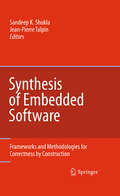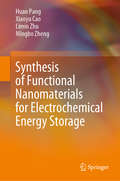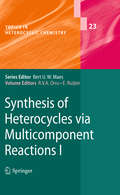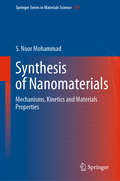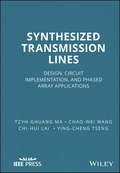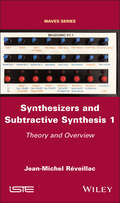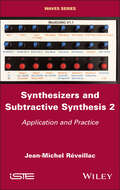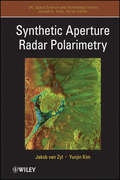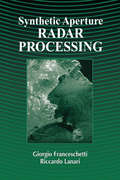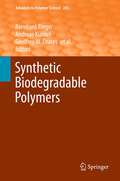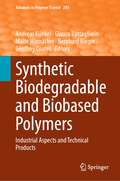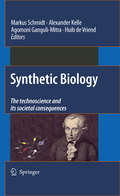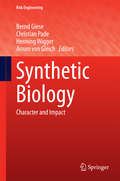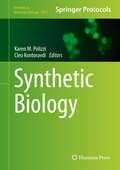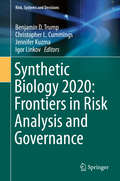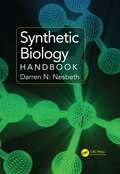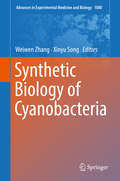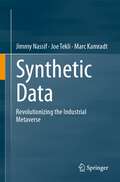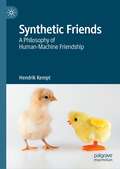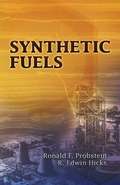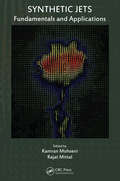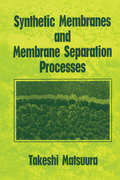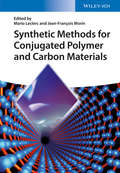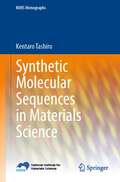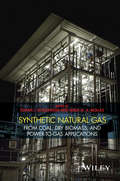- Table View
- List View
Synthesis of Embedded Software
by Jean-Pierre Talpin Sandeep Kumar ShuklaEmbedded software is ubiquitous today. There are millions of lines of embedded code in smart phones, and even more in systems responsible for automotive control, avionics control, weapons control and space missions. Some of these are safety-critical systems whose correctness, timely response, and reliability are of paramount importance. These requirement pose new challenges to system designers. This necessitates that a proper design science, based on "constructive correctness" be developed. Correct-by-construction design and synthesis of embedded software is done in a way so that post-development verification is minimized, and correct operation of embedded systems is maximized. This book presents the state of the art in the design of safety-critical, embedded software. It introduced readers to three major approaches to specification driven, embedded software synthesis/construction: synchronous programming based approaches, models of computation based approaches, and an approach based on concurrent programming with a co-design focused language. It is an invaluable reference for practitioners and researchers concerned with improving the product development life-cycle.
Synthesis of Functional Nanomaterials for Electrochemical Energy Storage
by Huan Pang Xiaoyu Cao Limin Zhu Mingbo ZhengThis book provides a comprehensive review of functional nanomaterials for electrochemical applications, presenting interesting examples of nanomaterials with different dimensions and their applications in electrochemical energy storage. It also discusses the synthesis of functional nanomaterials, including quantum dots; one-dimensional, two-dimensional and three-dimensional nanostructures; and advanced nanocomposites. Highlighting recent advances in current electrochemical energy storage hotpots: lithium batteries, lithium-ion batteries, sodium-ion batteries, other metal-ion batteries, halogen ion batteries, and metal–gas batteries, this book will appeal to readers in the various fields of chemistry, material science and engineering.
Synthesis of Heterocycles via Multicomponent Reactions II
by Romano V. Orru Eelco RuijterGéraldine Masson, Luc Neuville Carine Bughin Aude Fayol Jieping Zhu Multicomponent Syntheses of Macrocycles Thomas J.J. Müller Palladium-Copper Catalyzed Alkyne Activation as an Entry to Multicomponent Syntheses of Heterocycles Rachel Scheffelaar Eelco Ruijter Romano V.A. Orru Multicomponent Reaction Design Strategies: Towards Scaffold and Stereochemical Diversity Nicola Kielland Rodolfo Lavilla Recent Developments in Reissert-Type Multicomponent Reactions Jitender B. Bariwal Jalpa C. Trivedi Erik V. Van der Eycken Microwave Irradiation and Multicomponent Reactions Irini Akritopoulou-Zanze Stevan W. Djuric Applications of MCR-Derived Heterocycles in Drug Discovery
Synthesis of Nanomaterials: Mechanisms, Kinetics and Materials Properties (Springer Series in Materials Science #307)
by S. Noor MohammadThis book deals with the synthesis of nanomaterials with a strong focus on the underlying reaction kinetics and various synthesis mechanisms. It gives a detailed description of all major synthesis routes of many types of novel nanomaterials including nanowires, carbon nanotubes, semiconductor nanotubes, carbon nanobelts, nanofibers, nanorings, nanodots and quantum dots. In addition, it articulates the fundamental mechanisms of nanomaterials synthesis via vapor-phase, liquid-phase and solid-phase processes, highlighting the various strengths and weaknesses of each mechanism. This monograph provides the reader with a thorough review of the known state-of-the-art, along with a detailed comparison and analysis of all possible nanomaterials synthesis mechanisms. An important element of the book is how to obtain critical knowledge for controlling the morphology of nanomaterials and thereby fine tune their materials properties. The book is an ideal guide for graduate students and researchers new to the field seeking to establish or enhance their understanding of the physical and chemical fundamentals of nanomaterials synthesis mechanisms.
Synthesized Transmission Lines: Design, Circuit Implementation, and Phased Array Applications
by Chao-Wei Wang Chi-Hui Lai Tzyh-Ghuang Ma Ying-Cheng TsengAn original advanced level reference appealing to both the microwave and antenna communities * An overview of the research activity devoted to the synthesis of transmission lines by means of electrically small planar elements, highlighting the main microwave applications and the potential for circuit miniaturization* Showcases the research of top experts in the field* Presents innovative topics on synthesized transmission lines, which represent fundamental elements in microwave and mm-wave integrated circuits, including on-chip integration* Covers topics that are related to the microwave community (transmission lines), and topics that are related to the antenna community (phased arrays), broadening the readership appeal
Synthesizers and Subtractive Synthesis 1: Theory and Overview
by Jean-Michel RéveillacSubtractive sound synthesis has been one of the most widely used techniques in electronic music and for many analog synthesizers since the early 1960s. It is based on a simple principle, but its operation remains complex, involving many parameters. It can be enriched by a variety of effects that give the sound its authenticity. It does not just imitate musical instruments, but can also transcribe noises present in natural soundscapes, or generate entirely synthetic sounds. Synthesizers and Subtractive Synthesis 1 presents the theoretical basis of a sound phenomenon, the different types of synthesis, the components that are required and present in synthesizers, the working environment specific to the study of subtractive synthesis, and the hardware and software available. After reading the various chapters of this book, readers will have a clear vision of the tools and actions required to grasp the world of subtractive sound.
Synthesizers and Subtractive Synthesis, Volume 2: Application and Practice
by Jean-Michel RéveillacSubtractive sound synthesis is one of the most widely used techniques in electronic music and in many analog synthesizers since the early 1960s. It is based on a simple principle, but its operation is complex, involving many parameters. It can be enhanced by a variety of effects that give the sound its authenticity, and does not simply imitate musical instruments, but can also transcribe noises present in natural soundscapes or generate entirely synthetic sounds. Synthesizers and Subtractive Sound Synthesis 2 presents practical exercises, ranging from the fundamentals to advanced functionalities. Most of the sound effects applicable to subtractive synthesis are covered: vibrato, phaser, reverb, etc. The final chapters deal with polyphony and arpeggiator-sequences.
Synthetic Aperture Radar Polarimetry
by Jakob Van Zyl Yunjin KimThis book describes the application of polarimetric synthetic aperture radar to earth remote sensing based on research at the NASA Jet Propulsion Laboratory (JPL). This book synthesizes all current research to provide practical information for both the newcomer and the expert in radar polarimetry. The text offers a concise description of the mathematical fundamentals illustrated with many examples using SAR data, with a main focus on remote sensing of the earth. The book begins with basics of synthetic aperture radar to provide the basis for understanding how polarimetric SAR images are formed and gives an introduction to the fundamentals of radar polarimetry. It goes on to discuss more advanced polarimetric concepts that allow one to infer more information about the terrain being imaged. In order to analyze data quantitatively, the signals must be calibrated carefully, which the book addresses in a chapter summarizing the basic calibration algorithms. The book concludes with examples of applying polarimetric analysis to scattering from rough surfaces, to infer soil moisture from radar signals.
Synthetic Aperture Radar Processing
by Giorgio Franceschetti Riccardo LanariSynthetic Aperture Radar Processing simply and methodically presents principles and techniques of Synthetic Aperture Radar (SAR) image generation by analyzing its system transfer function. The text considers the full array of operation modes from strip to scan, emphasizes processing techniques, enabling the design of operational SAR codes. A simple example then follows.This book will be invaluable to all SAR scientists and engineers working in the field. It may be used as the basis for a course on SAR image generation or as a reference book on remote sensing. It contains a wide spectrum of information presented with clarity and rigor.
Synthetic Biodegradable Polymers
by Bernhard Rieger Andreas Künkel Robert Reichardt Geoffrey W. Coates Eckhard Dinjus Thomas A. ZevacoSalen Metal Complexes as Catalysts for the Synthesis of Polycarbonates from Cyclic Ethers and Carbon Dioxide, by Donald J. Darensbourg.- Material Properties of Poly(Propylene Carbonates), by Gerrit. A. Luinstra and Endres Borchardt.- Poly(3-Hydroxybutyrate) from Carbon Monoxide, by Robert Reichardt and Bernhard Rieger. - Ecoflex® and Ecovio®: Biodegradable, Performance-Enabling Plastics, by K. O. Siegenthaler, A. Künkel, G. Skupin and M. Yamamoto.- Biodegradability of Poly(Vinyl Acetate) and Related Polymers, by Manfred Amann and Oliver Minge.- Recent Developments in Ring-Opening Polymerization of Lactones, by P. Lecomte and C. Jérôme.- Recent Developments in Metal-Catalyzed Ring-Opening Polymerization of Lactides and Glycolides: Preparation of Polylactides, Polyglycolide, and Poly(lactide-co-glycolide), by Saikat Dutta, Wen-Chou Hung, Bor-Hunn Huang and Chu-Chieh Lin.- Bionolle (Polybutylenesuccinate), by Yasushi Ichikawa, Tatsuya Mizukoshi.- Polyurethanes from Renewable Resources, by David A. Babb.-
Synthetic Biodegradable and Biobased Polymers: Industrial Aspects and Technical Products (Advances in Polymer Science #293)
by Bernhard Rieger Andreas Künkel Glauco Battagliarin Malte Winnacker Geoffrey CoatesThis volume presents the recent developments in synthetic biodegradable and biobased polymers. The syntheses of many polymer types such as polyesters and polyamides, and also their processing technologies are discussed herein, and new aspects from fundamental and from industrial research are covered. This combination of both perspectives within this volume will be of interest for many research scientists from academia and industry and also for lectures and teachers. Chapters ''BioPBSTM (Polybutylene succinate)'' and ''Polymer biodegradability 2.0: A holistic view on polymer biodegradation in natural and engineered environments'' are available open access under a Creative Commons Attribution 4.0 International License via link.springer.com. For further details see license information in the chapter.
Synthetic Biology
by Alexander Kelle Markus Schmidt Agomoni Ganguli-Mitra Huib De VriendSynthetic biology is becoming one of the most dynamic new fields of biology, with the potential to revolutionize the way we do biotechnology today. By applying the toolbox of engineering disciplines to biology, a whole set of potential applications become possible ranging very widely across scientific and engineering disciplines. Some of the potential benefits of synthetic biology, such as the development of low-cost drugs or the production of chemicals and energy by engineered bacteria are enormous. There are, however, also potential and perceived risks due to deliberate or accidental damage. Also, ethical issues of synthetic biology just start being explored, with hardly any ethicists specifically focusing on the area of synthetic biology. This book will be the first of its kind focusing particularly on the safety, security and ethical concerns and other relevant societal aspects of this new emerging field. The foreseen impact of this book will be to stimulate a debate on these societal issues at an early stage. Past experiences, especially in the field of GM-crops and stem cells, have shown the importance of an early societal debate. The community and informed stakeholders recognize this need, but up to now discussions are fragmentary. This book will be the first comprehensive overview on relevant societal issues of synthetic biology, setting the scene for further important discussions within the scientific community and with civil society.
Synthetic Biology
by Bernd Giese Christian Pade Henning Wigger Arnim Von GleichSynthetic Biology is already an object of intensive debate. However, to a great extent the discussion to date has been concerned with fundamental ethical, religious and philosophical questions. By contrast, based on an investigation of the field's scientific and technological character, this book focuses on new functionalities provided by synthetic biology and explores the associated opportunities and risks. Following an introduction to the subject and a discussion of the most central paradigms and methodologies, the book provides an overview of the structure of this field of science and technology. It informs the reader about the current stage of development, as well as topical problems and potential opportunities in important fields of application. But not only the science itself is in focus. In order to investigate its broader impact, ecological as well as ethical implications will be considered, paving the way for a discussion of responsibilities in the context of a field at a transitional crossroads between basic and applied science. In closing, the requirements for a suitable regulatory framework are discussed. The book is intended as a source of information and orientation for researchers, students and practitioners in the natural sciences and technology assessment; for members of scientific and technological, governmental and funding institutions; and for members of the general public interested in essential information on the current status, prospects and implications of synthetic biology.
Synthetic Biology
by Karen M. Polizzi Cleo KontoravdiIn Synthetic Biology, expert researchers in the field provide the latest developments in molecular biology techniques used in Synthetic Biology. Focusing on computational tools that will aid in systematising the design and construction of parts and systems. Written in the highly successful Methods in Molecular BiologyTM series format, chapters include introductions to their respective topics, lists of the necessary materials and reagents, step-by-step, readily reproducible laboratory protocols, and key tips on troubleshooting and avoiding known pitfalls. Authoritative and practical, Synthetic Biology seeks to aid scientists in the further study of developing new biological components and systems.
Synthetic Biology 2020: Frontiers in Risk Analysis and Governance (Risk, Systems and Decisions)
by Igor Linkov Benjamin D. Trump Christopher L. Cummings Jennifer KuzmaSynthetic biology offers powerful remedies for some of the world’s most intractable problems, but these solutions are clouded by uncertainty and risk that few strategies are available to address. The incentives for continued development of this emerging technology are prodigious and obvious, and the public deserves assurances that all potential downsides are duly considered and minimized accordingly. Incorporating social science analysis within the innovation process may impose constraints, but its simultaneous support in making the end products more acceptable to society at large should be considered a worthy trade-off.Contributing authors in this volume represent diverse perspectives related to synthetic biology’s social sciences, and reflect on different areas of risk analysis and governance that have developed for the field. Such perspectives include leading scholarly discussion pertaining to risk assessment, governance, ethics, and communication. The chapters of this volume note that while the first twenty years of synthetic biology development have focused strongly on technological innovation and product development, the next twenty should emphasize the synergy between developers, policymakers, and publics to generate the most beneficial, well governed, and transparent technologies and products possible. Many chapters in this volume provide new data and approaches that demonstrate the feasibility for multi-stakeholder efforts involving policymakers, regulators, industrial developers, workers, experts, and societal representatives to share responsibilities in the production of effective and acceptable governance in the face of uncertain risk probabilities. A full consideration of such perspectives may prevent a world of draconian regulations based on an insufficient or incomplete understanding of the science that underpins synthetic biology, as well as any hesitancy or fear by the public to adopt its eventual products.
Synthetic Biology Handbook
by Darren N. NesbethThe Synthetic Biology Handbook explains the major goals of the field of synthetic biology and presents the technical details of the latest advances made in achieving those goals. Offering a comprehensive overview of the current areas of focus in synthetic biology, this handbook:Explores the standardisation of classic molecular bioscience approaches
Synthetic Biology of Cyanobacteria (Advances in Experimental Medicine and Biology #1080)
by Weiwen Zhang Xinyu SongThis volume highlights recent breakthroughs in the interdisciplinary areas of synthetic biology, metabolic engineering and bioprocess engineering for the production of green chemicals. It also presents practical experimental and computational tools for the design, construction and manipulation of cyanobacteria cell factories. The respective contributions cover new technologies in the field, such as novel genetic transformation techniques and bioinformatics analysis methods and address various aspects of cyanobacterial synthetic biology, offering a valuable resource for students and researchers in the fields of industry microbiology and biomedical engineering.
Synthetic Data: Revolutionizing the Industrial Metaverse
by Joe Tekli Jimmy Nassif Marc KamradtThe book concentrates on the impact of digitalization and digital transformation technologies on the Industry 4.0 and smart factories, how the factory of tomorrow can be designed, built, and run virtually as a digital twin likeness of its real-world counterpart, before the physical structure is actually erected.It highlights the main digitalization technologies that have stimulated the Industry 4.0, how these technologies work and integrate with each other, and how they are shaping the industry of the future.It examines how multimedia data and digital images in particular are being leveraged to create fully virtualized worlds in the form of digital twin factories and fully virtualized industrial assets. It uses BMW Group’s latest SORDI dataset (Synthetic Object Recognition Dataset for Industry), i.e., the largest industrial images dataset to-date and its applications at BMW Group and Idealworks, as one of the main explanatory scenarios throughout the book.It discusses the need of synthetic data to train advanced deep learning computer vision models, and how such datasets will help create the “robot gym” of the future: training robots on synthetic images to prepare them to function in the real world.
Synthetic Friends: A Philosophy of Human-Machine Friendship
by Hendrik KemptThis book explores the notion of whether we can be friends with machines in a philosophically meaningful way. Depending on our concept of friendship, we may be inclined to answer differently. Since social technology has made new forms of friendships possible between people across the globe, the author argues that the philosophical concept of friendship, forged thousands of years ago, should be re-examined. The author proposes a new approach to the debate that reflects the unique relationship we can build with machines as our synthetic friends.
Synthetic Fuels (Dover Books on Aeronautical Engineering)
by Ronald F. Probstein R. Edwin HicksThis book, the outgrowth of a graduate course the authors taught at the Massachusetts Institute of Technology, was designed to fill an urgent need--the training of engineers in the production of synthetic fuels to replace dwindling supplies of natural ones. The authors presented synthetic fuels as a unified engineering subject, while recognizing that many of its principles are well-understood aspects of various engineering fields.The presentation begins with a review of chemical and physical fundamentals and conversion fundamentals, and proceeds to coal gasification and gas upgrading. Subsequent chapters examine liquids and clean solids produced from coal, liquids obtained from oil shale and tar sands, biomass conversion, and environmental, economic, and related aspects of synthetic fuel use.The text is directed toward beginning graduate students and advanced undergraduates in chemical and mechanical engineering, but should also appeal to students from other disciplines, including environmental, mining, petroleum, and industrial engineering, as well as chemistry. It also serves as a reference and guide for professionals.
Synthetic Jets: Fundamentals and Applications
by Kamran Mohseni Rajat MittalCompiles Information from a Multitude of SourcesSynthetic jets have been used in numerous applications, and are part of an emergent field. Accumulating information from hundreds of journal articles and conference papers, Synthetic Jets: Fundamentals and Applications brings together in one book the fundamentals and applications of fluidic actuators.
Synthetic Membranes and Membrane Separation Processes
by Takeshi MatsuuraSynthetic Membranes and Membrane Separation Processes addresses both fundamental and practical aspects of the subject. Topics discussed in the book cover major industrial membrane separation processes, including reverse osmosis, ultrafiltration, microfiltration, membrane gas and vapor separation, and pervaporation. Membrane materials, membrane preparation, membrane structure, membrane transport, membrane module and separation design, and applications are discussed for each separation process. Many problem-solving examples are included to help readers understand the fundamental concepts of the theory behind the processes. The book will benefit practitioners and students in chemical engineering, environmental engineering, and materials science.
Synthetic Methods for Conjugated Polymer and Carbon Materials
by Jean-Francois Morin Mario LeclercA concise and practical overview of the most important modern synthetic aspects of conjugated polymers and carbon materials, including their properties and applications. Well structured, this book summarizes recent achievements, outlines the current state and reviews research trends. As such, a wide variety of polymerization techniques are included on both a strategic as well as a practical level, including Stille, Suzuki , and direct (hetero)arylation polymerizations. Furthermore, it covers various carbon-rich materials, such as graphene and carbon nanotubes, followed by a look at how the different synthetic pathways and strategies influence their final properties, for example, for use in organic electronic devices. The whole is rounded off with a discussion of future technology advances. An essential reference for newcomers as well as experienced researchers in the field.
Synthetic Molecular Sequences in Materials Science (Nims Monographs Series)
by Kentaro TashiroThis monograph shares a newly emerging point of view among researchers and students in the field of materials science. Inspired by the presence of precisely determined molecular-level sequence structures in a wide range of biomolecules, a growing number of synthetic compounds with the same structural feature are appearing day by day. These examples in the interdisciplinary areas of materials science are collected in this monograph to provide readers with a good understanding of the state-of-the-art accessible structural level, characteristic features, and future potentials of these types of compounds. The major target audience of this monograph include Ph.D. students and researchers who have just begun their careers, who are seeking novel research directions, ideas, and inspiration. Among the diverse examples of synthetic molecular sequences referred to in the monograph, experienced experts can also find work that is informative and relevant to their own research, making the book worthwhile reading for these specialists.
Synthetic Natural Gas from Coal, Dry Biomass, and Power-to-Gas Applications
by Tilman J. Schildhauer Serge BiollazProvides an overview of the different pathways to produce Synthetic Natural Gas Covers technological, and economic aspects of this Synthetic Natural Gas Details the most popular technologies and state-of-the-art of SNG technologies while also covering recent and future research trends Covers the main process steps during conversion of coal and dry biomass to SNG: gasification, gas cleaning, methanation and gas upgrading Describes a number of novel processes for the production of SNG with their specific combination of process steps as well as the boundary conditions Covers important technical aspects of Power-to-Gas processes
